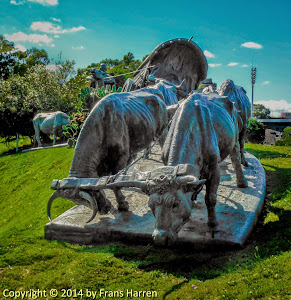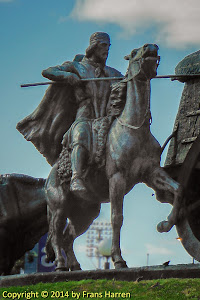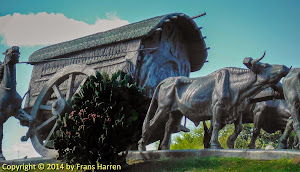La Carreta Monument
Sculptor: José Belloni (1882-1965)
Inauguration: October 14, 1934
Location: Parque Batlle y Ordoñez, on Avenida Dr. Lorenzo Merola
Material: Bronze
Base material: Bronze and pink granite
Description: It consists of a cart, three yoke of pulling oxen and two on the back. In front of the latter, to the right of the vehicle, a gaucho on horseback wielding the baton. The whole in the top of a grass covered slope, overlooking a pond in the growing "wild straw."
La Carreta Monument recalls the classic means of transport and loading, used by country people of our country, before the introduction of railways and motor. It is one of the most admired works of its kind, having achieved international fame.
José Belloni, son of European immigrants (1882-1965) settled with his family in Switzerland in 1890, where he studied and began his artistic career.
Years later, settled again in Uruguay, he worked as a professor in the Faculty of Architecture, keeping it parallel to the front of his shop with an amazing artistic production.
His works, located in preferential public places, part of Montevideo idiosyncrasy: Ansina, José Enrique Rodó, La Diligencia, Juan Manuel de Blanes, Dr. Luis Morquio, El Aguatero, El Entrevero or decorative figures and bas-reliefs in the Legislative Palace, among others.
Belloni monuments are an essential part of Uruguayan culture.
See: montevideo
Parque Batlle
Parque Batlle (formerly: Parque de los Aliados) is a barrio (neighbourhood or district) and a major public central park in Montevideo, Uruguay. It is named in honour of José Batlle y Ordóñez, President of Uruguay from 1911–1915.
Location
The barrio is located south of Italia Avenue and north of Rivera Avenue and includes the districts Belgrano, Italiano, Villa Dolores and the park area. It borders the barrios Tres Cruces to the west and north, La Blanqueada and Unión to the north, Buceo to the east and Pocitos to the south.
The park covers an area of 60 hectares and is considered the "lung" of Montevideo owing to the large variety of trees planted here. It is home to the Estadio Centenario national football stadium, as well as the national monument "La Carreta".
History
In 1907, Pablo Nereo Gabriel Antonio Pereira (1838–1906) donated eleven acres of his land, which was then named after him as "Campo Pereira," for a building a park, to the Economic Management Board, and the idea of a park was created by an Act of March 1907 which also projected wide boulevards and avenues. The project's landscape French architect, Carlos Thays, began the plantings in 1911 and completed it with all the attendant embellishments required for a park. In 1918, the park was named "Allied Park," following the allied Army winning the World War I thus honouring the heroes of the Allied Forces. The park was further expanded to the present status, which covers an area of 60 hectares (150 acres). This extension was made possible owing to an estate that Antonio Pereira in his "Will" had bequeathed partly to the municipality in May 1930. The Board then further acquired more land and created the Great Park Pereira seen in its present status. May 5, 1930, it was again renamed as Parque Batlle y Ordóñez, in memory of the prominent Politician and President of Uruguay, who had died in 1929. In the same year, the Estadio Centenario was opened. Between 1935 and 1938, the athletics track and the municipal velodrome were completed. It was designated a National Historic Monument Park in 1975.
See: wikipedia




















0 comments:
Post a Comment